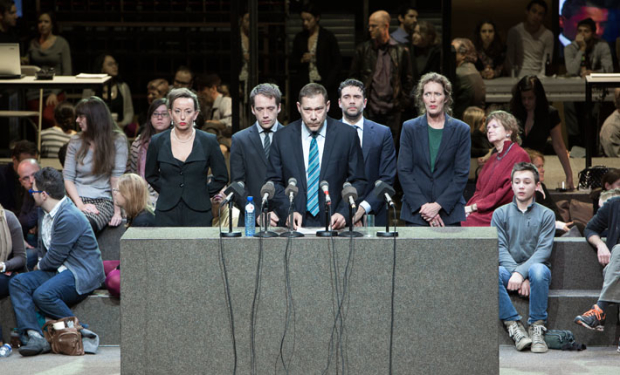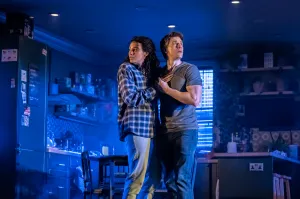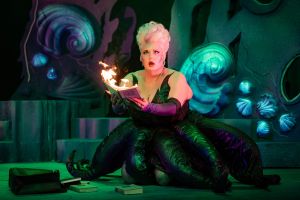Is Ivo van Hove's Roman Tragedies the most significant piece of theatre in Britain in a decade?
Toneelgroep’s six-hour adaptation of three of Shakespeare’s tragedies returned to the Barbican this month

© Jan Versweyveld
Remember 2009? That was as big a year for British theatre as I’ve ever known. Jez Butterworth’s Jerusalem and Lucy Prebble’s ENRON ran side-by-side. Katori Hall pipped both with The Mountaintop. Tim Crouch’s The Author and Mike Bartlett’s Cock. War Horse moved into the West End. NT Live beamed its first broadcast. Ontroerend Goed and Coney pushed interactivity. Shunt built its own three-storey stage. Kim Noble staged a suicide note and Nic Green shared her stage with women in Trilogy. National Theatre Wales launched. Steve Waters proved climate change could make good theatre.
In amidst all that, Roman Tragedies was easily overlooked. It ran for just three performances, and was seen by fewer than 3,500 people. There were a handful of reviews – several ecstatic, but others lukewarm. "Would I sit or slump through those six hours again?" asked Benedict Nightingale in The Times. "Probably not."
Roman Tragedies is the most significant piece of theatre in Britain over the past decade
I missed it back then. Despite being a committed Barbican convert, chewing over the entire BITE programme, I wrote this off as classical, not contemporary, work – a choice I spent years kicking myself over afterwards. At one point, I almost flew to Adelaide just to catch up.
Eight years on, having finally done so, it seems absolutely obvious that Roman Tragedies is the most significant piece of theatre in Britain over the past decade. More than War Horse. More than Jerusalem. More than Three Kingdoms. Maybe even more than the Donmar’s Shakespeare Trilogy, though that runs it close. Since 2009, Ivo van Hove and Jan Versweyveld have changed the fundamentals of British theatre.
Their mantra – that any production ought to tap into the core essence of a play – has caught on like a wildfire, ushering in a new age of minimalism onstage that has chimed, rather perfectly, with an age of austerity. Directors today aspire to excise anything extraneous or outmoded. They question everything. It’s not just that van Hove pulls plays into the present, dishing them up in modern dress and panning for contemporary resonance. He hoiks plays out of specific settings altogether. He suspends them in space and so shows us people, not products of a particular time and place. It’s one of the reasons his work travels so well. He drills into drama like a speculator striking oil.
Van Hove’s productions exist on stages, not on sets, not in settings
Space is key. Van Hove’s productions exist on stages, not on sets, not in settings. They are sewn into theatres and, if van Hove and Versweyveld have had any one impact, it is this: the two of them have taught artists to use theatres as site-specific spaces. They use the semiotics of auditoria to make meaning, asking us to examine not just what we’re watching, but how we’re watching it.
Roman Tragedies rams that home. Turning us, the theatre audience, into the play’s people, Rome’s citizens, they fuse the real and the fictional space together: both the Barbican and Rome at once. It matters that the doors are open and that we can come and go as we please. This isn’t a separate space, but a continuation of the world. It doesn’t stop us being citizens for real. Rolling tickers fuse updates from Shakespeare’s Rome with headlines from our world: Trump, Volscians, Manchester United, Egypt.
They invite us onstage, to watch from within; a mark of our involvement, as citizens, in the news cycle. From the stalls, we can sit back and scan the whole, but onstage, our perspective is compromised. We chose what to watch, and how; whether to interact or not – to tweet or not to tweet, etc etc. We notice what ends up on camera and what not; the reality behind the images of politics. We have freedom, but we don’t have control.
Van Hove and Versweyveld have do this in show after show. Kings of War slips seamlessly from live footage to pre-recorded images, asking us to question what we can trust or what we can ever really know of war. One fire extinguisher shifts Hedda Gabler’s flat from the domestic sphere to an aesthetic one; a white living room becomes a gallery space and Hedda, an objet d’art. With no exit she seems trapped, but, as everyone else enters from the auditorium, she never once steps offstage. If she’s a prisoner, she never tries to escape.
More than any other theatre artists, van Hove and Versweyveld are sculptors of the stage
Scenes from a Marriage, their take on Ingmar Bergman’s television series, overlaid three separate scenes in one space simultaneously, each audible over the others, so that one marriage became the sum total of two lives. Each partner became many different people as the relationship renews itself, sheds its skin every seven years or so. Finally, all six actors share a vast, empty stage for the same scene. The pairs shuffle, married to memories and to strangers.
Watching A View From the Bridge a third time, from the side of the stage, I remember clocking how Mark Strong’s Eddie stood between his niece and the lone exit at all times. How, at different points, every character mirrored a moment of Eddie’s physicality in the same spot on stage – as if each of them contained something of him, as if none were immune.
More than any other theatre artists, van Hove and Versweyveld are sculptors of the stage. They create theatrical objects: events with fixed configurations in both time and space. Each is a complete whole. It has its own internal logic.
This is what has caught on across Britain and beyond. It’s in the slow spin of Robert Icke’s idle Uncle Vanya or the sliding frames of The Red Barn. It’s in Joe Hill-Gibbins’ deconstructed auditoria, where Edward II’s exiles enter from the theatre’s roof and Measure for Measure‘s invisible underworlds exist offstage. It’s in Soutra Gilmour extending the Olivier theatre’s décor into Antigone’s world and in the slow light fade of Nat Martello-White’s Torn, tricking our body clocks and draining our bodies. Much, much more besides.
Roman Tragedies made space significant – much more so than scenery.













